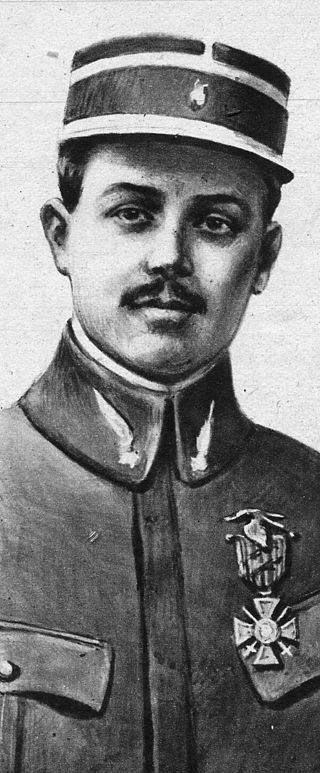Related Research Articles

Georges Guynemer was the second highest-scoring French fighter ace with 54 victories during World War I, and a French national hero at the time of his death. Guynemer's death was a profound shock to France.

George von Lengerke Meyer was a Massachusetts businessman and politician who served in the Massachusetts House of Representatives, as United States ambassador to Italy and Russia, as United States Postmaster General from 1907 to 1909 during the administration of President Theodore Roosevelt and United States Secretary of the Navy from 1909 to 1913 during the administration of President William Howard Taft.

Edward Ball Cole was an officer in the United States Marine Corps during World War I. He was a leading expert on machine guns; he was killed in action during the Battle of Belleau Wood.

Sir Horatio Gilbert George Parker, 1st Baronet, known as Gilbert Parker, Canadian novelist and British politician, was born at Camden East, Addington, Ontario, the son of Captain Joseph Parker, R.A.
Hermann Hagedorn was an American author, poet and biographer.

Mark Antony De Wolfe Howe Jr. was an American editor, author, and recipient of the 1925 Pulitzer Prize for Biography or Autobiography.

Arthur Raymond Brooks was an American World War I flying ace of the United States Army Air Service credited with shooting down multiple enemy aircraft. Among his most prominent achievements was when he single-handedly took on a squadron of German-flown Fokker planes officially downing 2 of them in one aerial battle piloting his Smith IV Spad XIII. He was a pioneer in the development of radio navigational aids (NAVAIDs) used by pilots for location and navigation as well as air-to-ground communications. Brooks also participated in early endeavors to commercialize aviation as a passenger-carrying business and was one of the earliest commercial pilots involved with carrying mail for the US Post Office Department.

Walter Lovell was a World War I volunteer pilot and an American serviceman. He was born in Newton, Massachusetts, to Wallace D. and Josephine (Hastings) Lowell. Walter attended Newton High School and graduated from Harvard College with a Bachelor of Arts degree, class of 1907. He stayed in Boston and went into brokerage business after graduation.

Hamilton "Ham" Coolidge, was an American pursuit pilot, flying ace in World War I, and recipient of the Distinguished Service Cross.

Major Charles John Biddle was an American aviator, attorney, and author. He was a flying ace during World War I. Postwar, he launched a career in law and wrote his memoirs.
Group Captain John Leacroft MC & Bar was a World War I fighter ace credited with 22 victories. He remained in the Royal Air Force until 1937, and returned to service during World War II in administrative roles.

Leutnant Rudolf Friedrich Otto Windisch was a World War I fighter ace credited with 22 victories.
Capitaine Raoul Cesar Robert Pierre Echard was a World War I flying ace credited with seven aerial victories.
Major Karl Waldemar Ritscherle was a World War I flying ace credited with eight aerial victories. He served again in the World War II Luftwaffe, and was killed in action when his Heinkel 111 was shot down and fell into Abberton Reservoir.

The 103rd Aero Squadron was an aviation pursuit squadron of the U.S. Air Service that served in combat in France during World War I. Its original complement included pilots from the disbanded Lafayette Escadrille and Lafayette Flying Corps. One of those pilots, Paul F. Baer, became the first ace of an American unit in World War I.

Capitaine Albert Louis Deullin was a French World War I flying ace credited with twenty aerial victories. He served for the entirety of World War I. By war's end, he had risen to command of a fighter wing. He would die in a postwar flying accident.

Lieutenant Frank Leaman Baylies was an American World War I flying ace credited with twelve aerial victories while flying in the French Aeronautique Militaire. Having originally volunteered for the Ambulance Corps, Baylies transferred into French aviation in May 1917. After scoring his 12 victories with the French, he transferred into American aviation service but remained with the French until his death in action.
Sous lieutenantCharles Alfred Quette was a French World War I flying ace credited with ten confirmed and five unconfirmed aerial victories.

Captain Thomas Gantz Cassady (1896-1972) was an American fighter pilot who served in two World Wars, and was successful in business during peacetime.

Lionel de Jersey Harvard was a young Englishman who, discovered to be collaterally descended from Harvard College founder John Harvard, was consequently offered the opportunity to attend that university, from which he graduated in 1915. The first Harvard to attend Harvard, he died in the First World War less than three years later, leaving a wife and infant son.
References
- 1 2 3 4 De Wolfe Howe, 1922
- 1 2 3 US War memorial - Dudley Gilman Tucker - Retrieved July 11, 2013.
- ↑ "Tucker, Dudley Gilman | Columbia University Libraries". library.columbia.edu. Retrieved 2022-12-13.
Bibliography
- De Wolfe Howe, Mark Antony (1922). Harvard dead in the war against Germany. Vol. III. Cambridge MA: Harvard University Press.